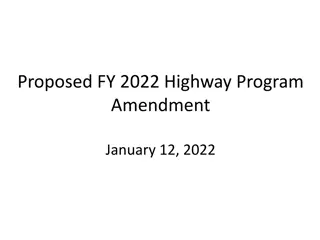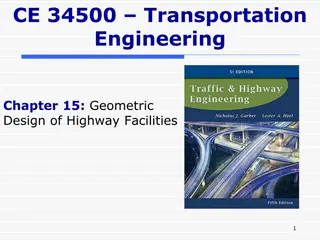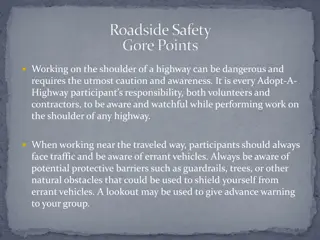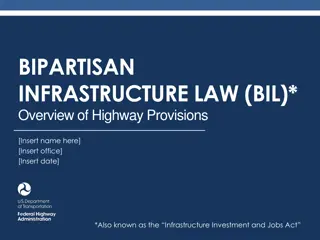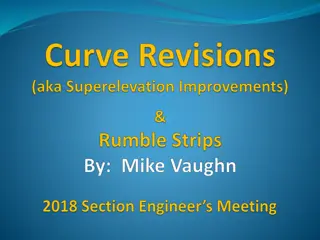Structural Design of Highway
The structural design of highway pavements involves principles and methods for flexible pavement design, as outlined by AASHTO. Factors like performance period, analysis period, and maintenance levels play crucial roles in optimizing pavement structure longevity and performance. Various references, including the work of Yoder & Witczak, contribute to the understanding and implementation of pavement design techniques.
Download Presentation

Please find below an Image/Link to download the presentation.
The content on the website is provided AS IS for your information and personal use only. It may not be sold, licensed, or shared on other websites without obtaining consent from the author.If you encounter any issues during the download, it is possible that the publisher has removed the file from their server.
You are allowed to download the files provided on this website for personal or commercial use, subject to the condition that they are used lawfully. All files are the property of their respective owners.
The content on the website is provided AS IS for your information and personal use only. It may not be sold, licensed, or shared on other websites without obtaining consent from the author.
E N D
Presentation Transcript
Structural Design of Highway Flexible Pavement Design Highway and Transportation Engineering Al-Mustansiriyah University 2019-2020 Dr. Rana Amir Yousif & Dr. Abeer K. Jameel Yoder; E. J. and M. W. Witczak, Principles of Pavement Design , A Wiley- Interscience Publication, John Wiley & Sons Inc., U.S.A., 1975.
References Nicholas J. Garber and Lester A. Hoel. Traffic and Highway Engineering , Fourth Edition. Yoder; E. J. and M. W. Witczak, Principles of Pavement Design , A Wiley- Interscience Publication, John Wiley & Sons Inc., U.S.A., 1975. Yaug H. Huang, Pavement Analysis and Design , Prentic Hall Inc., U.S.A., 1993. AASHTO Guide for Design of Pavement Structures 1993 , AASHTO, American Association of State Highway and Transportation Officials, U.S.A., 1993. Oglesby Clarkson H., HighwayEngineering , John Wiley & Sons Inc., U.S.A., 1975. Yoder; E. J. and M. W. Witczak, Principles of Pavement Design , A Wiley- Interscience Publication, John Wiley & Sons Inc., U.S.A., 1975.
AASHTO METHOD The design procedure recommended by the American Association of State Highway and Transportation Officials (AASHTO) is based on the results of the extensive AASHO Road Test conducted in Ottawa, Illinois, in the late 1950s and early 1960s . The AASHO Committee on Design first published an interim design guide in 1961 . It was revised in 1972 and 1981 . In 1984-85, the Subcommittee on Pavement Design and a team of consultants revised and expanded the guide under NCHRP Project 20-7/24 ; they issued the guide in 1986 . The guide was revised in 1993 with practically no change in the design method presented in this section . Yoder; E. J. and M. W. Witczak, Principles of Pavement Design , A Wiley- Interscience Publication, John Wiley & Sons Inc., U.S.A., 1975.
11.3 AASHTO METHOD 11 .3.1 Design Variables Several general design variables related to both flexible and rigid pavements are presented in this section . Time Constraints To achieve the best use of available funds, the AASHTO design guide encourages the use of a longer analysis period for high-volume facilities, including at least one rehabilitation period . Thus, the analysis period should be equal to or greater than the performance period, as described below. Performance Period The performance period refers to the time that an initial pavement structure will last before it needs rehabilitation or the performance time between rehabilitation operations . It is equivalent to the time elapsed as a new, reconstructed, or rehabilitated structure deteriorates from its initial serviceability to its terminal serviceability. Yoder; E. J. and M. W. Witczak, Principles of Pavement Design , A Wiley- Interscience Publication, John Wiley & Sons Inc., U.S.A., 1975.
11.3 AASHTO METHOD 11 .3.1 Design Variables The designer must select the performance period within the minimum and maximum allowable bounds that are established by agency experience and policy. Note The selection of performance period can be affected by such factors: The functional classification of the pavement. The type and level of maintenance applied. The funds available for initial construction. Life cycle costs. and other engineering considerations. Yoder; E. J. and M. W. Witczak, Principles of Pavement Design , A Wiley- Interscience Publication, John Wiley & Sons Inc., U.S.A., 1975.
11.3 AASHTO METHOD 11 .3.1 Design Variables Analysis Period The analysis period is the period of time that any design strategy must cover . It may be identical to the selected performance period performance limitations may necessitate the consideration of staged construction or planned rehabilitation for the desired analysis period . Table 11.13 contains general guidelines for the length of the analysis period . .However, realistic Yoder; E. J. and M. W. Witczak, Principles of Pavement Design , A Wiley- Interscience Publication, John Wiley & Sons Inc., U.S.A., 1975.
11.3 AASHTO METHOD 11 .3.1 Design Variables Traffic:The design procedures are based on cumulative expected 18-kip (80-kN) equivalent single-axle load (ESAL) . If a pavement is designed for the analysis period without any rehabilitation or resurfacing, all that is required is the total ESAL over the analysis period . However, if stage construction is considered and rehabilitation or resurfacing is anticipated, a graph or equation of cumulative ESAL versus time is needed so that the ESAL traffic during any given stages can be obtained . Note Yoder; E. J. and M. W. Witczak, Principles of Pavement Design , A Wiley- Interscience Publication, John Wiley & Sons Inc., U.S.A., 1975.
11.3 AASHTO METHOD 11 .3.1 Design Variables Reliability:The design procedures are based on cumulative expected 18-kip (80-kN) equivalent single-axle load (ESAL) . Yoder; E. J. and M. W. Witczak, Principles of Pavement Design , A Wiley- Interscience Publication, John Wiley & Sons Inc., U.S.A., 1975.
11.3 AASHTO METHOD 11 .3.1 Design Variables Application of the reliability concept requires the selection of a standard deviation that is representative of local conditions . It is suggested that standard deviations of 0 .49 be used for flexible pavements and 0 .39 for rigid pavements. These correspond to variances of 0 .2401 and 0 .1521, which are nearly the same as those shown in Table 10.12 .. When stage construction is considered, the reliability of each stage must be compounded to achieve the overall reliability ; that is, (11.28) in which n is the number of stages being considered . For example, if two stages are contemplated and the desired level of overall reliability is 95%, the reliability of each stage must be (0 .95) ^1/2 , or 97.5% . Yoder; E. J. and M. W. Witczak, Principles of Pavement Design , A Wiley- Interscience Publication, John Wiley & Sons Inc., U.S.A., 1975.
11.3 AASHTO METHOD 11 .3.1 Design Variables Environmental Effects :The AASHO design equations were based on the results of traffic tests over a two-year period . The long-term effects of temperature and moisture on the reduction of serviceability were not included . If problems of swell clay and frost heave are significant in a given region and have not been properly corrected, the loss of serviceability over the analysis period should be estimated and added to that due to cumulative traffic loads . Figure 11.23 shows the serviceability loss versus time curves for a specific location . Yoder; E. J. and M. W. Witczak, Principles of Pavement Design , A Wiley- Interscience Publication, John Wiley & Sons Inc., U.S.A., 1975.
11.3 AASHTO METHOD 11 .3.1 Design Variables Yoder; E. J. and M. W. Witczak, Principles of Pavement Design , A Wiley- Interscience Publication, John Wiley & Sons Inc., U.S.A., 1975.
11.3 AASHTO METHOD 11 .3.1 Design Variables The environmental loss is a summation of losses from both swelling and frost heave . The chart may be used to estimate the serviceability loss at any intermediate period, for example, a loss of 0 .73 at the end of 13 years . Of course, if only swelling or frost heave is considered, there will be only one curve on the graph . The shape of these curves indicates that the serviceability loss due to environment increases at a decreasing rate. This may favor the use of stage construction because most of the loss will occur during the first stage and can be corrected with little additional loss in later stages. Yoder; E. J. and M. W. Witczak, Principles of Pavement Design , A Wiley- Interscience Publication, John Wiley & Sons Inc., U.S.A., 1975.
11.3 AASHTO METHOD 11 .3.1 Design Variables ServiceabilityInitial and terminal serviceability indexes must be established to compute the change in serviceability, APSI, to be used in the design equations . The initial serviceability index is a function of pavement type and construction quality . Typical values from the AASHO Road Test were 4.2 for flexible pavements and 4.5 for rigid pavements. is the lowest index that will be tolerated before rehabilitation, resurfacing, and reconstruction become necessary. The terminal serviceability index Yoder; E. J. and M. W. Witczak, Principles of Pavement Design , A Wiley- Interscience Publication, John Wiley & Sons Inc., U.S.A., 1975.
11.3 AASHTO METHOD 11 .3.1 Design Variables An index of 2.5 or higher is suggested for design of major highways and 2.0 for highways with lower traffic. For relatively minor highways where economics dictate a minimum initial capital outlay, it is suggested that this be accomplished by reducing the design period or total traffic volume, rather than by designing a terminal serviceability index less than 2.0 . Yoder; E. J. and M. W. Witczak, Principles of Pavement Design , A Wiley- Interscience Publication, John Wiley & Sons Inc., U.S.A., 1975.
Structural Design of Highway Dr. Rana Amir Yousif & Dr. Abeer K. Jameel Yoder; E. J. and M. W. Witczak, Principles of Pavement Design , A Wiley- Interscience Publication, John Wiley & Sons Inc., U.S.A., 1975.





